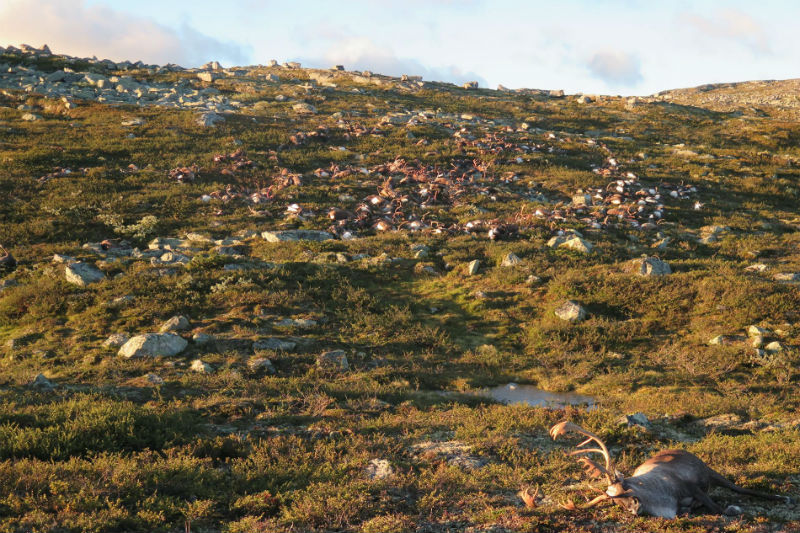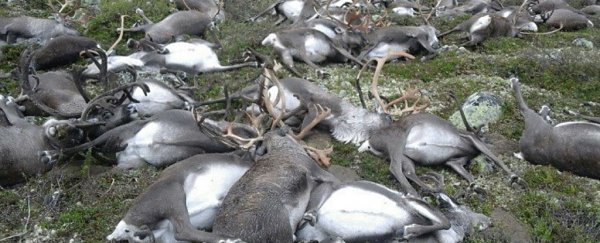More than 300 wild reindeer have been killed by a lighting strike in a Norwegian national park, and experts say they've never seen anything like it.
While details about the incident are still forthcoming, it's suspected that the reindeer huddled together in the rain, and when the lightning hit, its energy travelled across the ground and up the animals' legs, killing them where they stood.
"We are not familiar with any previous happening on such a scale," Kjartan Knutsen from the Norwegian Environment Agency told The New York Times.
"Individual animals do from time to time get killed by lightning, and there are incidents where sheep have been killed in groups of 10 or even 20, but we have never seen anything like this."
The victims belonged to Europe's largest wild reindeer herd, numbering 10,000 or so in Norway's Hardangervidda national park - the largest high mountain plateau in northern Europe, spanning some 8,000 square kilometres (3,088 square miles).
At the last count, 323 reindeer had been confirmed dead from the August 26 incident, including 70 calves. So far, five reindeer that survived the storm with severe wounds have been put down.
So how could something like this happen?
As Knutsen mentioned above, lightning strikes are known to occasionally kill pack animals in large numbers, because they tend to congregate under the trees in bad weather.
When lightning hits, you'd have to be extremely unlucky to be the 'primary flash channel' into which all its electricity is funnelled, but animals are often felled by a ground current, where the electricity races either towards or branches out from the flash channel.
"First, there's a direct strike - this is what most people think of when they think of lightning - that hits the tree or maybe the ground nearby," John Jensenius, a lightning safety expert from the US National Oceanic and Atmospheric Administration (NOAA), told Angela Chen at The Verge.
"The energy then spreads along the ground surface, and if you're anywhere near that lightning strike, you absorb it and get shocked."
The fact that the ground would have been soggy from all the rain that day also meant that it would have been a very good conductor for all that branching ground current.
And not only did the herd's instinct to huddle together backfire on them, their own bodies rendered them the perfect receptacles for all that electricity.
 Norwegian Environment Agency
Norwegian Environment Agency
As with many quadrupedal animals that have been felled en masse by lightning, including sheep and cattle, their back and front legs are so far apart, that by the time the electric current travels between them, it's been able to develop a high potential difference, and current always flows from a higher potential to a lower potential.
It's the same principal at play when you see a bird sitting on a power line and not getting electrocuted - there is no potential difference because both its legs are touching the same wire at same constant potential.
But if it stretches out a leg or a wing, or touches another wire, the current suddenly has somewhere to go, and through the bird it zips.
So yep, with the crazy amount of rain seeping into the already fast-thawing ground, those lightning rod legs, and that steadfast pack mentality, these poor reindeer had a whole lot going against them that day.
But if you're looking for a silver lining in this grisly event, there is one… kinda.
As Knutsen explained to Henrik Pryser Libell at The Times, something called chronic wasting disease - a contagious neurological disorder related to mad cow disease - had been detected in reindeer in southern Norway back in March.
There's now an ongoing investigation into how bad the spread of this disease in the local reindeer population is, and Knutsen said the corpses of the lightning victims will provide a considerable sample for analysis.
"The test results for the herd killed by lightning can give crucial answers in understanding how much the disease has spread," he said.
Here's some footage of the site, if you feel like your day needs more reindeer corpses:
